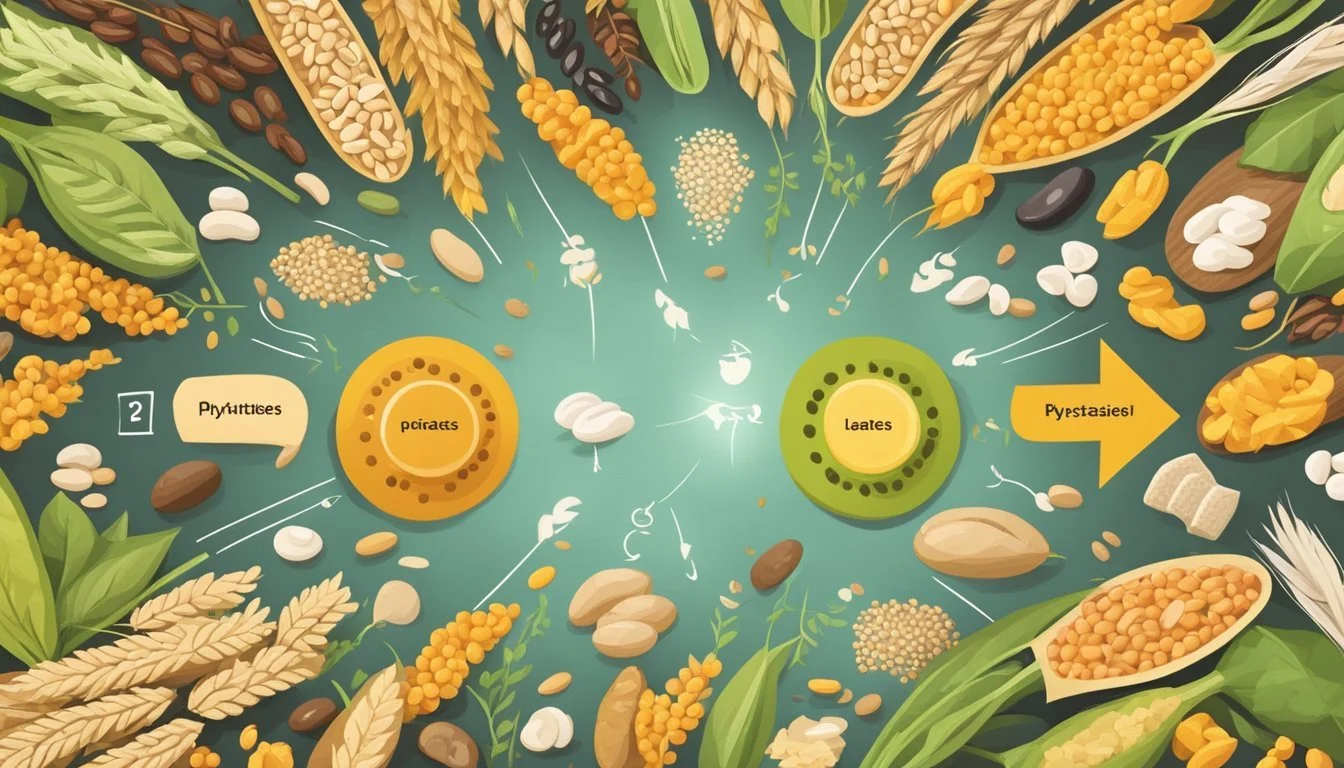Are Phytates in Whole Grains and Legumes Harmful or Beneficial?
Unraveling the Myths and Facts
Phytic acid, also known as phytates, is a natural substance found in plant-based foods like whole grains, legumes, nuts, and seeds. It serves as the principal storage form of phosphorus in these foods, which is crucial for their growth and development. While there's a common perception that phytates can hinder the absorption of essential minerals such as iron, zinc, and manganese in the human body, they also exhibit antioxidant properties. These antioxidative capabilities indicate a possible role in health promotion, especially within the context of a balanced diet.
The debate over phytates' impact on health stems from their dual nature. On one hand, phytates can bind to minerals and affect their bioavailability. In populations that rely heavily on grain and legume staples with limited access to a diverse range of foods, this can contribute to deficiencies. On the other hand, a balanced diet rich in a variety of foods can offset potential mineral absorption issues. Furthermore, methods like soaking, sprouting, and fermenting grains and legumes can significantly reduce phytate content, enhancing the nutritional profile of these plant-based foods.
Nutritionists and health experts often emphasize the importance of including whole grains and legumes in a well-rounded diet for their fiber, vitamins, and plant-based protein. The presence of phytates in such foods does not negate their health benefits. In fact, some research suggests that phytates can be part of a protective mechanism against certain chronic diseases, thanks to their antioxidant properties. Considering the dynamics of an entire dietary pattern is key to understand the role of phytates in health.
Phytates Defined
Phytates, commonly found in various plant-based foods, are often misunderstood. This section demystifies their nature, common sources, and composition within different foods.
What Are Phytates?
Phytates, the salts or esters of phytic acid, serve as the primary storage form of phosphorus in many plant tissues, especially beans, seeds, nuts, and whole grains. While often referenced in the context of nutrition as anti-nutrients, phytates possess a range of both potentially beneficial and hindering properties, depending on the dietary context.
Sources of Phytates
The following are key sources of phytates:
Legumes: Beans, lentils, chickpeas
Grains: Especially in whole grains like wheat, rice, and corn
Seeds: Including sesame, flaxseeds, and sunflower seeds
Nuts: Such as almonds, walnuts, and brazil nuts
These foods contribute to the intake of phytates in diets that are rich in plant-based foods.
Phytate Composition in Foods
The concentration of phytates in plant foods varies widely. Factors influencing these levels include the type of seed, growing conditions, and soil quality. In foods, phytic acid may bind to minerals such as iron, zinc, and magnesium, thereby affecting their absorption in the human gut. However, the effect on mineral absorption can differ based on food preparation methods and individual diets.
Nutritional Implications
Phytates, present in whole grains and legumes, harbor a dual nature with respect to human nutrition—on one hand potentially hindering mineral absorption, while on the other possibly offering protective health benefits.
Impact on Mineral Absorption
Phytates have a strong affinity to dietary minerals such as iron, zinc, calcium, and magnesium, forming insoluble complexes which can inhibit their absorption in the human digestive tract. This phenomenon is particularly evident in plant-based diets where high-phytate foods are a staple. Evidence suggests that diets high in phytic acid could lead to suboptimal iron and zinc absorption.
Iron: Binding with phytates decreases iron absorption; a critical issue in regions where diets are primarily plant-based without sufficient iron-rich or enhancing foods.
Zinc: Phytates reduce bioavailability of zinc; essential for immune system function and cellular growth.
Effect on Nutrient Bioavailability
The binding of phytates to minerals, while sometimes reducing mineral absorption, does not necessarily translate directly to mineral deficiencies. Phytate's role is nuanced; cooking, fermenting, and soaking practices can lessen its effect, thereby improving mineral bioavailability.
Cooking: Reduces phytate levels and may help enhance mineral absorption.
Fermenting & Soaking: Break down phytate, thus potentially increasing micronutrient bioavailability.
Phytates and Mineral Deficiencies
While excessive intake of phytates can contribute to mineral deficiencies, societies consuming balanced diets often compensate for phytate's potential negative impact. Moreover, the body adapts to higher phytate intake over time by increasing the efficiency of mineral absorption and micronutrients reuse.
Calcium: Data suggests a moderate intake of phytates may not significantly affect calcium absorption, particularly when dietary calcium levels are adequate.
Phosphorus: As phytic acid is a storage form of phosphorus in plants, it is typically not implicated in phosphorus deficiencies.
Health Benefits of Phytates
Phytates, found in whole grains and legumes, have been recognized for their health benefits, particularly their antioxidant effects, protection against chronic diseases, and a potential role in cancer prevention.
Antioxidant Properties
Phytates possess strong antioxidant properties that help in protecting the body's cells against damage from free radicals. This action is beneficial in reducing oxidative stress, a factor involved in aging and various diseases.
Protection Against Chronic Diseases
Consuming foods rich in phytates has been linked with a lower risk of several chronic diseases, notably cardiovascular disease. The compounds have been observed to improve heart health by potentially lowering cholesterol levels and blood pressure.
Preventive Role in Cancer
Research indicates that phytates may have a preventive role against certain types of cancer. By promoting cellular health and reducing inflammation, they contribute to the body’s natural defense mechanisms against cancerous cell growth.
Processing and Cooking Methods
The processing and cooking methods employed can significantly alter the phytic acid content in whole grains and legumes, affecting nutrient bioavailability and absorption.
Effect of Soaking and Sprouting
Soaking beans and grains is known to reduce phytic acid content, enhancing the availability of minerals for absorption. Sprouting further decreases phytates and improves the overall nutrient profile.
Soaking: Involves immersing the grains or legumes in water for a period, which activates enzymes that break down phytic acid.
Sprouting: After soaking, allowing the seeds to germinate reduces anti-nutrients and can increase the content of beneficial nutrients.
Impact of Fermentation
Fermentation is another potent method that significantly diminishes phytate levels. Sourdough bread—a result of fermentation—has shown a marked reduction in phytic content compared to its non-fermented counterparts.
Sourdough: Using fermented starter, resulting in lower phytate levels and higher nutrient absorption.
Bioavailability: Increased mineral uptake due to the reduced presence of phytates.
The Role of Cooking and Heat
Cooking applies heat to food, which can lead to a reduction in phytic acid. The degree of this reduction depends on the cooking time and temperature.
Cooking: Legumes cooked at 95°C can lose a substantial amount of phytic acid, from 20-80%.
Heat: Not only does it reduce phytic acid, but also increases the digestibility and availability of other nutrients.
Dietary Considerations and Recommendations
In evaluating the role of phytates in the diet, it is important to consider dietary patterns, approaches to balancing phytate intake, and potential needs for nutrient supplementation to ensure a balanced and nutrient-rich diet.
Plant-based Diets and Vegetarianism
Individuals following plant-based diets, such as vegetarians and vegans, often consume higher levels of phytates due to their increased intake of whole grains, legumes, nuts, and seeds. While these components are nutrient-dense and provide essential protein, they also contain phytates, which can bind to minerals and potentially affect their absorption. To offset this, vegetarians and vegans should include mineral-absorbing enhancers, like vitamin C found in citrus fruits, vitamin C-fortified foods, and antioxidants in their meals, which can enhance the bioavailability of these nutrients.
Balancing Phytate Intake
A diet inclusive of phytate-containing foods can be beneficial—provided there's a balance. Phytates have antioxidant properties, but they can also impede the absorption of minerals like iron, zinc, and calcium to some extent. Incorporating foods that are high in these minerals and consuming them alongside phytate-containing foods are both strategies to ensure a balanced intake. For example:
Iron: Pairing spinach with vitamin C-rich lemon juice may enhance absorption.
Zinc: Including garlic and onions in meals can increase the uptake of zinc from phytate-containing foods.
Nutrient Supplementation
Although phytate intake from a varied and balanced diet is generally not a concern, there might be cases where nutrient supplementation is needed, particularly in individuals with restricted diets or specific health considerations. Supplements of iron, zinc, or calcium, for example, may be necessary under medical supervision. When deciding on supplementation, it is crucial to consider dietary sources first and the timing of taking these supplements in relation to meals to avoid interactions with phytate-rich foods.
Additional Factors Influencing Phytate Impact
The impact of phytates on health is not uniform; it varies depending on individual health conditions and environmental and dietary contexts. Certain populations and health conditions may experience different effects.
Individual Health Status
Individuals with anemia, particularly iron-deficiency anemia, may need to consider their intake of phytates. Phytates reduce the absorption of heme-iron, which is crucial for those already struggling with low iron levels. Osteoporosis patients should also be aware of phytates’ potential to bind minerals, which might affect bone density. However, it's essential to note that the relationship between phytate intake and mineral deficiencies is complex and not solely responsible for these conditions.
For those with kidney stones, phytates might actually be beneficial. Phytates can bind and inhibit the crystallization of certain minerals that contribute to the formation of kidney stones. In contrast, individuals managing type 2 diabetes may see improvements in their condition due to phytates' role in enhancing insulin sensitivity.
Digestive health is another area where phytates can have a variable impact. While they may decrease mineral absorption in the digestive tract, they could also have prebiotic effects, promoting gut health.
Environmental and Dietary Variables
The effect of phytates also varies with environmental and dietary factors. In developing countries, where diets are heavily reliant on phytate-rich foods like legumes and grains without sufficient meat or ascorbic acid, the risk of mineral deficiencies increases. Conversely, the environmental condition of food production can change phytate levels in crops through soil mineral content and farming practices.
Variables such as food preparation techniques can also influence phytate's effects. Soaking, fermenting, and sprouting of grains and legumes can lower phytate content and thus mitigate potential negative impacts on mineral absorption. In regions with a high exposure to lead or other heavy metals, phytates can reduce heavy metal absorption, offering a protective role.
In summary, phytates’ impact on health is multifaceted and depends on numerous personal and environmental factors. Individuals should consider these additional factors alongside broader dietary patterns to fully understand the role of phytates in their diet.
Future Research and Perspectives
The exploration of phytates’ health implications and their role in nutrition science is poised for breakthroughs and reconsideration of longstanding beliefs.
Advancements in Phytate Research
Research laboratories around the world continue to study phytates extensively, focusing on their potential health benefits and mechanisms of action. In vitro studies have provided promising insights, particularly in the context of phytates' impact on cancer cells. There is a growing body of evidence suggesting that phytates may induce apoptosis in various cancerous cell lines, and further lab research is paramount to understand the pathways involved. Future studies might delve into how phytates interact with natural killer cells, components of the immune system that play a crucial role in cancer defense. Additionally, advancements in detecting and quantifying phytate content in plant foods can result in more accurate dietary recommendations.
Evolving Perspectives on Phytates in Diet
The perspective on phytates in the diet is undergoing a transformation as emerging research challenges the assertion that phytates only enact negative effects due to mineral binding. Scholars are considering the broader implications of phytates on health, including their antioxidant properties and role in reducing the risk of chronic diseases. Researchers aim to provide a nuanced view of phytate intake, highlighting both the potential protective benefits and the importance of balanced consumption. Future dietary guidelines may reflect this evolving understanding, prioritizing a harmonious intake of phytates that fosters benefits without impeding mineral absorption.





